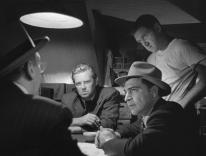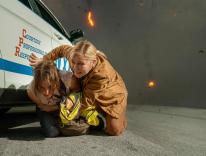“You took the best / Now take the rest,” the blues singer offers her lover in despair. But Peter Jackson, adapting Alice Sebold’s overrated but fairly touching bestseller The Lovely Bones, did just the opposite: he took the worst of the book and gave it cinematic shine, then merely skimmed the rest.
This tale of a murdered fourteen-year-old whose spirit hovers over her bereaved family and follows its fortunes over the next decade features a limbo compounded of maudlin dreaminess and descriptive banality, but from its vantage point the dead Susie, a truly omniscient narrator, relays some well-observed scenes of middle-class life in a small Pennsylvania town of the 1970s, all of it wasted on Peter Jackson. The director of Lord of the Rings knows what movies are meant to do when they’re fueled by a gazillion dollars and employ a special-effects staff that includes Joe Letteri, who worked with James Cameron on Avatar. This script either breezes through or eliminates ten years of mourning, family squabbles, detective work, courtships, adultery, a community’s rites of compassion, a classmate’s struggles to become a poet while being tormented by clairvoyance, and much, much else. This isn’t a case of the sort of abridgement every script must extract from any novel. It’s a total refocus that turns a novelist’s attempt at quiet poignancy into a director’s opportunity for a big cinematic bang.
This results in a queasy movie, though not a total fiasco. Susie’s dwelling place in the afterlife, uninteresting in the novel, here becomes a kinetic version of Magritte’s paintings: visions of gazebos hovering over lakes and overtopped by a huge clock, cornfields turning into swamps, overlappings of summer and winter. All of which is a good try at portraying a spirit wandering through the motifs of a short life until she can transcend the material world.
Sebold’s exploration of the murderer’s mind (how does a psycho get through his average, uneventful day?) made him seem interestingly mundane, and the scene in the novel when Susie’s sister Lindsey burgles Mr. Harvey’s house to find incriminating clues concentrates on Lindsey’s extrasensory contact with Harvey’s previous victims rather than her own physical danger. But Jackson isn’t having any of that in the film. He shoves the episode closer to the end so that it becomes a conventional serial-killer movie climax, and cuts back and forth between oncoming madman and fleeing girl in such classic thriller style that I expect the scene will be used in film school (Editing 101) for some time to come.
But the book’s real climax is when Susie’s spirit inhabits the body of a former classmate, Ruth (now an adult), so that she can make love with Ray, her former dreamboat (now also very much grown up). The scene was embarrassing enough in print but the movie verges on the obscene as the twenty-two-year-old Ruth morphs into the fourteen-year-old Susie with the adult Ray on top of her. What was Peter Jackson thinking? When pedophiles die and go to perverts’ heaven, will they watch this scene on their celestial DVD players?
With two shining exceptions, the film is miscast. Rachel Weisz and Mark Wahlberg, as Susie’s parents, register as movie stars trying to be ordinary. Susan Sarandon turns the slightly eccentric grandmother into an Auntie Mame freak. Reece Ritchie as Ray has the looks of a Bollywood god, which doesn’t make him the best choice to portray an awkward high-school boy. As Lindsey, Rose McIver is inexpressive. Michael Imperioli plays the detective pretty much the way he played the Mafioso punk on The Sopranos, though I trust this isn’t a comment on Pennsylvania law enforcement.
But those exceptions! Stanley Tucci, that genius chameleon, employs the murderer’s ordinariness not just as a disguise but as a major component of his horror. And the radiance of Saoirse Ronan as Susie, outdoing all the movie’s special effects, should make this Irish teenager a star. (And if that happens, will millions learn how to pronounce her name?)
The movie’s epilogue explains the title. Those “bones” are the loving relationships formed among the living after the tragedy of a girl’s murder. They are the triumph of the ordinary beauty of everyday life over violent death. But precisely what’s missing in this noisy, garish, intermittently entertaining film is the feel of everyday life.
When Brokeback Mountain was released, some critics praised it as a serious work about two gay men but didn’t regard it as a gay movie, while others (notably Daniel Mendelsohn in the New York Review of Books) argued that it was an artistically praiseworthy gay film. I was in the former camp and still am. Now we have A Single Man, Tom Ford’s adaptation of Christopher Isherwood’s 1964 novel, and I think it is both a good movie and a gay movie. What’s the difference between Single Man and Brokeback?
For me, subject matter alone doesn’t make a drama homosexual or heterosexual. The scope of the story must be considered, as well as the context of the sexuality and, most important, the style of the language or imagery, which may decisively display a gay, straight, or bisexual sensibility. In Brokeback Mountain, we saw the cowboys as lovers of both men and women, and the heterosexual couplings were neither more nor less graphic than the homosexual ones. Much more importantly, the sexuality of the protagonists was placed within the context of family life, jobs, finances, aging. There was no doubt that their gay relationship meant more, emotionally, to the men than their marriages, yet we experienced the full spectrum of two lives and weren’t locked exclusively into the heat of their sexual experiences. Was the sensibility of the movie gay? Ang Lee’s camera photographed the wintry Montana sky with more sensuality than the male body.
Single Man is different. Its very drama depends on us not only understanding its hero’s sexual orientation but vividly feeling his sexual drive. For this is the story of one day in the life of George Falconer, a British professor of literature at a small California college. Plunged into deep depression by the death of his longtime lover, George decides to commit suicide by day’s end. We follow him as he ties up loose ends in his business and teaches what he intends to be his last classes. But Eros circumvents Thanatos and finally quenches it.
At first, there are only fleeting beefcake glimpses of attractive boys playing tennis or strolling on campus. Then there is an encounter with a Spanish hustler whom George befriends but doesn’t hire. Finally and decisively, he spends an evening with a student obviously seeking both physical love and emotional guidance from his teacher. Again, no actual sex occurs, but director Tom Ford makes us feel George’s reawakened sex drive by focusing on flesh, muscles, sinews, and youthful vitality. Sexual attraction isn’t the only thing that undermines his suicide plan—George is also concerned about a female friend and ex-lover, appreciates the sweetness of a neighboring child, and is irritated by his students’ complacency—but it’s the main thing. Like Peter Jackson, Ford has streamlined his literary source. In the book George’s attraction to the boy is more Socratic than physical, and I regret the way Ford has limited actor Colin Firth’s chances to display the intellectuality that Isherwood gave his hero. Nevertheless, the director’s alterations don’t blur the story’s theme.
Tom Ford has enjoyed a long and successful career as a fashion designer, and the first fifteen minutes of this, his debut film, made me fear we were going to get cinematic filigree instead of a real drama: too many arty camera angles as well as the draining and restoration of color to indicate the ebb and flow of George’s life force (a device that needed to be executed with more psychological consistency). Before long, though, the director settles down to telling his story and supporting his superb actors. Firth capitalizes on his specialty: British blandness masking British melancholy equals British pathos (the eternal kingdom of Noel Coward). As the frustrated ex-girlfriend, Julianne Moore perfectly complements Firth—all jangled nerves and diva peremptoriness, yet somehow likable.
Please email comments to [email protected] and join the conversation on our Facebook page.
Previous Story
‘Está Perdido’
Next Story
He’s Got Rhythm


